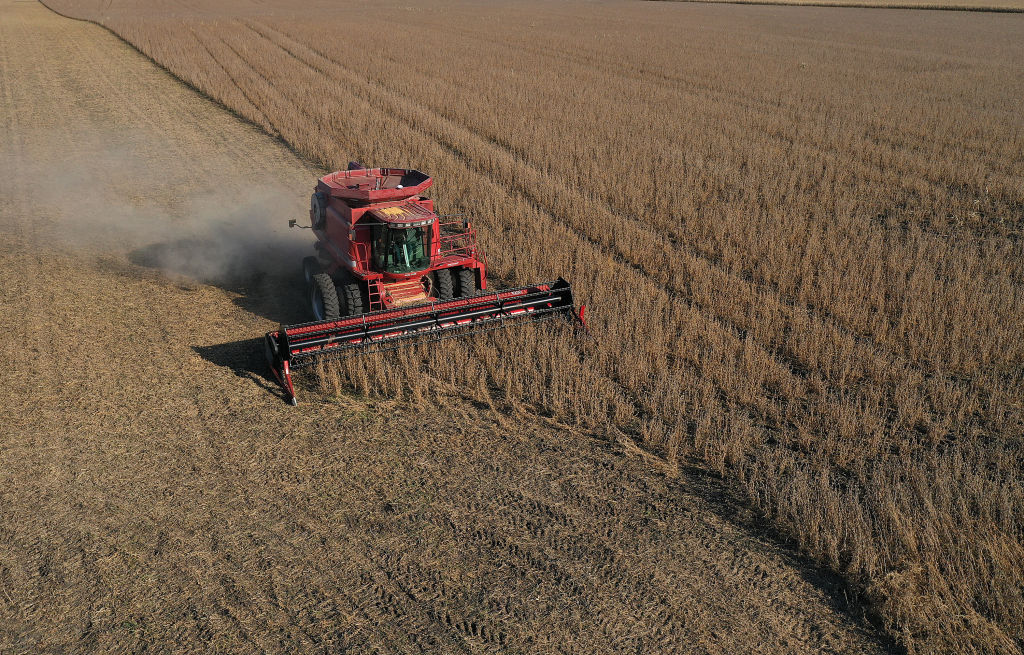13:00
News Story
Farmers likely to see more multinational trade deals crafted in Biden administration
The unknown factor is what China wants, said Seth Meyer of the Food and Agricultural Policy Research Institute at the University of Missouri.
WASHINGTON—American farmers who have gone through the drama and turbulence of trade and agriculture policy in the Trump administration can expect a far more sedate and multinational experience when President-elect Joe Biden takes office in January.
On just the third day of his administration, President Donald Trump rattled world leaders and upended exports by announcing that he would pull the United States out of a trade deal with other Pacific countries that he claimed was a bad deal for American workers.
It was a sign of more to come. The Republican president threatened to leave NAFTA, gummed up the operations of the World Trade Organization and started a trade war with China.
American farmers often bore the brunt of those moves. Countries retaliated against Trump’s protectionist moves by levying tariffs on everything from soybeans to blueberries.
American whiskey exports to the European Union dropped by 27 percent, after the EU imposed retaliatory tariffs on the spirits in 2018. Likewise, pork exports to Mexico fell 28 percent from 2018 to 2019 because of a trade dispute. China went from buying $12.2 billion of U.S. soybeans in 2017 to $3.1 billion the next year, because of the trade war. In Maine, a blueberry boom suddenly went bust, as exports to China plunged by 97 percent in two years.
While U.S. subsidies and subsequent trade deals alleviated some of the heartburn farmers felt, the unrest throughout the Trump administration left American agricultural exporters on edge.
Nonetheless, Trump enjoyed wide political support in rural America, where farmers worried that a Biden administration could bring more environmental regulation. In September, Farm Futures reported that three-quarters of farmers they surveyed said they’d be backing Trump in the election.
While Biden may be less politically aligned with farmers, he is unlikely to make such a startling debut on agriculture and trade policy.
He will have many pressing matters domestically —starting with getting the COVID-19 pandemic under control—that will likely occupy his attention early in the administration.
And observers expect that Biden will work to boost trade by crafting multinational agreements, rather than the one-on-one deals Trump favored, that take months, if not years, to complete.
“I think it’s fair to say that the president-elect is not going to use tariffs in the same way the Trump administration has been using them. I think it’s also fair to say that in efforts to hold countries like China accountable, you’ll see a more collaborative effort with other nations,” said Tom Vilsack, a former Iowa governor and agriculture secretary in the Obama administration, in an interview with States Newsroom. Vilsack also helped the Biden campaign develop its agricultural platform.
“That means a more stable market situation, which I think farmers would appreciate,” added Vilsack, who is now the president and CEO of the U.S. Dairy Export Council.
Trump trade deals

Biden will also take over at a time when exporters are still optimistic about gains they made under Trump’s most significant trade deals.
Those are a “Phase One” agreement with China that Trump agreed to in January in order to stop the trade war, and the United States-Mexico-Canada Agreement that updated a trade pact among the North American countries that was first crafted in the 1990s.
Both deals contain provisions that U.S. agricultural interests like, such as Chinese promises to increase their purchases of agricultural products and Canadian assurances that it would open its markets further to U.S. milk and dairy sales.
But it would be up to the incoming Biden administration to ensure that those goals are met.
Biden has also promised he “won’t enter into any new trade agreements until we’ve made major investments here at home, in our workers and our communities—equipping them to compete and win in the global economy. That includes investing in education, infrastructure, and manufacturing here at home.”
Relations with China
Biden, like Trump, has criticized China’s trade policies. He reiterated Thursday that he wants China to understand it has to “play by the rules.”
But the incoming president has said he would handle disputes with the Asian rival differently than Trump.
“I will do something Trump hasn’t done and can’t do: I will rally the world to support the U.S. in its fights with China and other countries that violate trade rules. [Trump] can’t build a coalition against our adversaries when he insults and embarrasses our friends. But, where needed, a Biden administration will fight for fair trade on our own,” he said in response to a questionnaire from steelworkers.
When it comes to agricultural products, though, relations between the two countries have been improving.
Under the Phase One agreement, China agreed to take steps to make its markets and regulatory processes more transparent. The changes, for example, could make it easier for U.S. companies to get approval to sell genetically modified crops.
The Chinese also promised to significantly increase the amount of agricultural goods they bought from the United States under the agreement. Their targets would amount to a 50 percent increase over what China bought in 2017, which was a good trade year.
China will almost certainly not make those targets, but it has been buying a significant amount of U.S. corn and soybeans since late summer, which has driven up prices.
“China is buying based on what its needs are,” said Randy Gordon, president of the National Grain and Feed Association, which represents grain elevators, processors and exporters.
Swine herds in China were devastated in recent years by the African swine flu, but now China is rebuilding those herds. That requires a lot of feed.
“Soybeans are going through the roof right now. We’re seeing record amounts of corn exports into China,” he said. “That’s been a real boon for American agriculture. It has really helped strengthen our farm prices.”
The big unknown factor, though, is what China wants, cautions Seth Meyer, the associate director of the Food and Agricultural Policy Research Institute at the University of Missouri.
In recent years, China has switched up its purchasing patterns to respond to both political and economic developments, but only temporarily, he noted.
So Meyer said it’s too early to tell whether the recent surge in Chinese purchases means that it will return to buying the same amount of American crops as it did before the trade war.
“It’s an open question right now: Is this demand transient, or is this a signal that we are back to Chinese demand really driving what’s going on in the market for now with row crops?” he said.
A return to normal?

One step the new administration could take to ensure more trade in the future, would be to reduce or remove the tariffs both countries imposed during the U.S.-China trade war, said Grant Kimberly, director of market development for the Iowa Soybean Association.
China, which buys 60 percent of all soybeans globally, agreed to let its buyers get exemptions from the tariffs that are currently under place. “But they could quickly put those right back in place if they wanted to, because they’re technically still there,” Kimberly said.
Mary Lovely, a senior fellow at the Peterson Institute and an economics professor at Syracuse University, said those kinds of concessions would be key to returning U.S.-Chinese relations to normal.
“If there’s going to be some type of rapprochement with China on this, there’s going to have to be negotiations before that between the Chinese and the Americans that deescalate the conflict and result in some other wins from both sides,” she said.
Any adjustments in U.S. trade policy toward China could have ripple effects in other markets, too.
Earlier this month, China and 14 other countries signed onto a trade deal called the Regional Comprehensive Economic Partnership. That lowers barriers between China and signatories including Japan, South Korea, Australia and New Zealand.
In response to the news, Biden said the United States should be aligned with other democracies “so that we can set the rules of the road instead of having China and others dictate outcomes because they are the only game in town.”
But when Trump decided to withdraw the United States from the Trans Pacific Partnership early in his presidency, the remaining countries forged an agreement without the United States.
President Barack Obama had argued that the TPP was necessary to act as a counterbalance to China in the Pacific region, but many of his fellow Democrats soured on the deal. Biden has said he would only consider joining the new agreement if more concessions were made.
In the meantime, the United States has tried to expand into new markets and increase its market share in other places to boost its agricultural exports.
“For example, we’ve seen [the Trump administration] push with several of our trading partners to get them to lower tariffs on … lobsters,” said Lovely, the Syracuse professor. “It’s not a main line agricultural product, but it was very important to Maine.”
“The problem is that farmers built those markets in China over a 20-year period. It’s very hard to instantly turn around and create new markets. They’re built on trust,” she said.
Many times, American exporters specialize their products for specific foreign markets. “This cannot be turned around on a dime. How President-elect Biden will approach this is difficult to see.”
Canada markets and U.S. dairy products

One of the concessions the United States gained in the USMCA was the promise from Canada that it would open its markets to more American dairy products.
“Canada has always been a tough one to work with on dairy. They’re very protective of their dairy industry,” said Rick Ebert, the president of the Pennsylvania Farm Bureau and a dairy farmer himself. “Hopefully, with a new trade agreement in place, some of the things they put into place to get more dairy into Canada will come to fruition.”
Still, as Canada has released more details about its plans, American dairy officials have grown concerned.
Vilsack, the head of the dairy exporters group, said the “spirit and the letter” of the USMCA made clear that Canada would “open new market opportunities that didn’t exist before.” But the way Canada has structured its rules, the companies that could import more American dairy products would have little incentive to do so.
“You want to make sure that, as [Canada] gets rid of its pricing systems… they don’t replace it with something that basically operates in the same way to distort the market,” he said.
Vilsack said dairy farmers would “hope that the president-elect’s approach to trade would be to make sure that the deals that have been negotiated… are implemented in the way they were intended.”
But Edward Alden, a senior fellow at the Council on Foreign Relations, said a bigger question might be how high of a priority the Biden administration would put on following up on those kinds of issues.
“I strongly expect the labor enforcement will be the top priority. If you look at the political problem that the Biden administration has on trade, it has to reassure union-leaning Democrats that whatever trade agenda it pursues is consistent with expansion of labor rights,” he said.
Environmental protection figures to be a top priority too.
Expanding dairy exports would likely be a lower priority for the Biden administration, he said.
“Canadian milk is a problem up in Wisconsin,” Alden added, “but it doesn’t move votes in the Democratic Party the same way labor rights in Mexico does, so I think [labor issues] will clearly be the priority.”
WTO, talks with the UK
One of the first tests the Biden administration will face on international trade is how it will respond to an impasse with the World Trade Organization, which resolves trade disputes between countries. The United States has long taken issue with aspects of how the WTO operates, but Trump escalated matters by blocking the appointment of judges to handle appeals and by blocking the appointment of a new director.
Meanwhile, the United Kingdom’s exit from the European Union will require follow-up negotiations with Britain that have the potential to open new markets or to solidify the United States’ existing relationships there.
Most observers expect the Biden administration to avoid the fireworks of the Trump administration. Even if Biden wants to draw a hard line with countries like China, rallying countries to the cause could take longer than leaving—or threatening to leave—trade partnerships, as Trump did.
“It’s like entropy applied to economics and politics,” said John Beghin, an agricultural economist and faculty member of the Yeutter Institute of International Trade and Finance at the University of Nebraska-Lincoln. “It takes time to build things, but it doesn’t take much time to destroy them or to get out of them.”
Our stories may be republished online or in print under Creative Commons license CC BY-NC-ND 4.0. We ask that you edit only for style or to shorten, provide proper attribution and link to our website. AP and Getty images may not be republished. Please see our republishing guidelines for use of any other photos and graphics.





